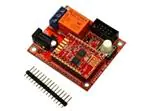ESP8266EX Datasheet
Version 4.4
Espressif Systems IOT Team
http://bbs.espressif.com/
Copyright © 2015
�
ESP8266 Datasheet
Espressif Systems
Disclaimer and Copyright Notice
Information in this document, including URL references, is subject to change without notice.
THIS DOCUMENT IS PROVIDED "AS IS" WITH NO WARRANTIES WHATSOEVER,
INCLUDING ANY WARRANTY OF MERCHANTABILITY, NON-INFRINGEMENT, FITNESS FOR
ANY PARTICULAR PURPOSE, OR ANY WARRANTY OTHERWISE ARISING OUT OF ANY
PROPOSAL, SPECIFICATION OR SAMPLE. All liability, including liability for infringement of
any proprietary rights, relating to use of information in this document is disclaimed. No
licenses express or implied, by estoppel or otherwise, to any intellectual property rights are
granted herein.
The Wi-Fi Alliance Member Logo is a trademark of the WiFi Alliance.
All trade names, trademarks and registered trademarks mentioned in this document are
property of their respective owners, and are hereby acknowledged.
Copyright © 2015 Espressif Systems. All rights reserved.
Espressif Systems
2/31
August 1, 2015
�
ESP8266 Datasheet
Espressif Systems
Table of Contents
1.
2.
3.
General Overview ..................................................................................................6
1.1.
Introduction..............................................................................................................6
1.2.
Features ....................................................................................................................7
1.3.
Parameters ...............................................................................................................7
1.4.
Ultra Low Power Technology ..................................................................................9
1.5.
Major Applications ..................................................................................................9
Hardware Overview ............................................................................................11
2.1.
Pin Definitions ..........................................................................................................11
2.2.
Electrical Characteristics ........................................................................................13
2.3.
Power Consumption .............................................................................................13
2.4.
Receiver Sensitivity ...............................................................................................14
2.5.
MCU ........................................................................................................................15
2.6.
Memory Organization ..........................................................................................15
2.6.1.
Internal SRAM and ROM ......................................................................................15
2.6.2.
External SPI Flash ..................................................................................................15
2.7.
AHB and AHB Blocks ............................................................................................16
Pins and Definitions ............................................................................................17
3.1.
GPIO .......................................................................................................................17
3.1.1.
General Purpose Input/Output Interface (GPIO) ..............................................17
Espressif Systems
3/31
August 1, 2015
�
ESP8266 Datasheet
Espressif Systems
4.
3.2.
Secure Digital Input/Output Interface (SDIO) ...................................................18
3.3.
Serial Peripheral Interface (SPI/HSPI) ..................................................................18
3.3.1.
General SPI (Master/Slave) ..................................................................................18
3.3.2.
SDIO / SPI (Slave) .................................................................................................19
3.3.3.
HSPI (Master/Slave) ..............................................................................................19
3.4.
Inter-integrated Circuit Interface (I2C) ...............................................................19
3.5.
I2S ...........................................................................................................................20
3.6.
Universal Asynchronous Receiver Transmitter (UART) .....................................20
3.7.
Pulse-Width Modulation (PWM) ..........................................................................21
3.8.
IR Remote Control .................................................................................................22
3.9.
ADC (Analog-to-digital Converter) .....................................................................22
3.10.
LED Light and Button............................................................................................24
Firmware & Software Development Kit ...........................................................26
4.1.
Features ..................................................................................................................26
5.
Power Management ............................................................................................27
6.
Clock Management .............................................................................................28
7.
6.1.
High Frequency Clock ..........................................................................................28
6.2.
External Reference Requirements.......................................................................29
Radio .....................................................................................................................29
7.1.
Channel Frequencies ............................................................................................30
7.2.
2.4 GHz Receiver ...................................................................................................30
7.3.
2.4 GHz Transmitter ..............................................................................................30
Espressif Systems
4/31
August 1, 2015
�
ESP8266 Datasheet
Espressif Systems
7.4.
8.
Clock Generator ....................................................................................................30
Appendix: QFN32 Package Size.......................................................................31
Espressif Systems
5/31
August 1, 2015
�
ESP8266 Datasheet
Espressif Systems
1.
1.1.
General Overview
Introduction
Espressif Systems’ Smart Connectivity Platform (ESCP) is a set of high performance, high integration
wireless SOCs, designed for space and power constrained mobile platform designers. It provides
unsurpassed ability to embed WiFi capabilities within other systems, or to function as a standalone
application, with the lowest cost, and minimal space requirement.
Figure 1 ESP8266EX Block Diagram
ESP8266EX offers a complete and self-contained WiFi networking solution; it can be used to host the
application or to offload WiFi networking functions from another application processor.
When ESP8266EX hosts the application, it boots up directly from an external flash. In has integrated
cache to improve the performance of the system in such applications.
Alternately, serving as a WiFi adapter, wireless internet access can be added to any micro controllerbased design with simple connectivity (SPI/SDIO or I2C/UART interface).
ESP8266EX is among the most integrated WiFi chip in the industry; it integrates the antenna
switches, RF balun, power amplifier, low noise receive amplifier, filters, power management modules,
it requires minimal external circuitry, and the entire solution, including front-end module, is designed
to occupy minimal PCB area.
ESP8266EX also integrates an enhanced version of Tensilica’s L106 Diamond series 32-bit processor,
with on-chip SRAM, besides the WiFi functionalities. ESP8266EX is often integrated with external
sensors and other application specific devices through its GPIOs; sample codes for such applications
are provided in the software development kit (SDK).
Espressif Systems
6/31
August 1, 2015
�
ESP8266 Datasheet
Espressif Systems
Espressif Systems’ Smart Connectivity Platform (ESCP) demonstrates sophisticated system-level
features include fast sleep/wake context switching for energy-efficient VoIP, adaptive radio biasing
for low-power operation, advance signal processing, and spur cancellation and radio co-existence
features for common cellular, Bluetooth, DDR, LVDS, LCD interference mitigation.
1.2.
Features
•
802.11 b/g/n
•
Integrated low power 32-bit MCU
•
Integrated 10-bit ADC
•
Integrated TCP/IP protocol stack
•
Integrated TR switch, balun, LNA, power amplifier and matching network
•
Integrated PLL, regulators, and power management units
•
Supports antenna diversity
•
WiFi 2.4 GHz, support WPA/WPA2
•
Support STA/AP/STA+AP operation modes
•
Support Smart Link Function for both Android and iOS devices
•
SDIO 2.0, (H) SPI, UART, I2C, I2S, IR Remote Control, PWM, GPIO
•
STBC, 1x1 MIMO, 2x1 MIMO
•
A-MPDU & A-MSDU aggregation & 0.4s guard interval
•
Deep sleep power
